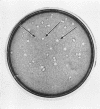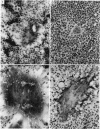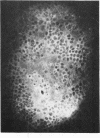Abstract
Rapp, Fred (Baylor University College of Medicine, Houston, Tex.). Plaque differentiation and replication of virulent and attenuated strains of measles virus. J. Bacteriol. 88:1448–1458. 1964.—Plaque formation by strains of measles virus in a stable line of African green monkey kidney cells (BSC-1) is characterized by development of large plaques (>1 mm) within 4 days after inoculation of the cultures with the virulent Edmonston strain or by small plaques (<1 mm) after inoculation with the attenuated Edmonston strain of virus. Plaque formation by measles virus is not influenced by iododeoxyuridine, cytosine arabinoside, isatinthiosemicarbazone, streptonigrin, actinomycin D, or mitomycin C. The predominant cytopathic effect observed with both strains is the formation of large, multinucleated giant cells. Development of the giant cells is correlated with development of virus antigen and synthesis of infectious virus. Synthesis of virus is similar at 34 and at 37 C. Appearance of intracellular virus precedes release, and is later in the attenuated virus-infected cells than in cells infected with the virulent strain. With the virulent strain, equal concentrations of intra- and extracellular virus are found but, with attenuated virus, only a small fraction reaches the extracellular fluids, and more than 95% of the newly synthesized virus remains cell-associated.
Full text
PDF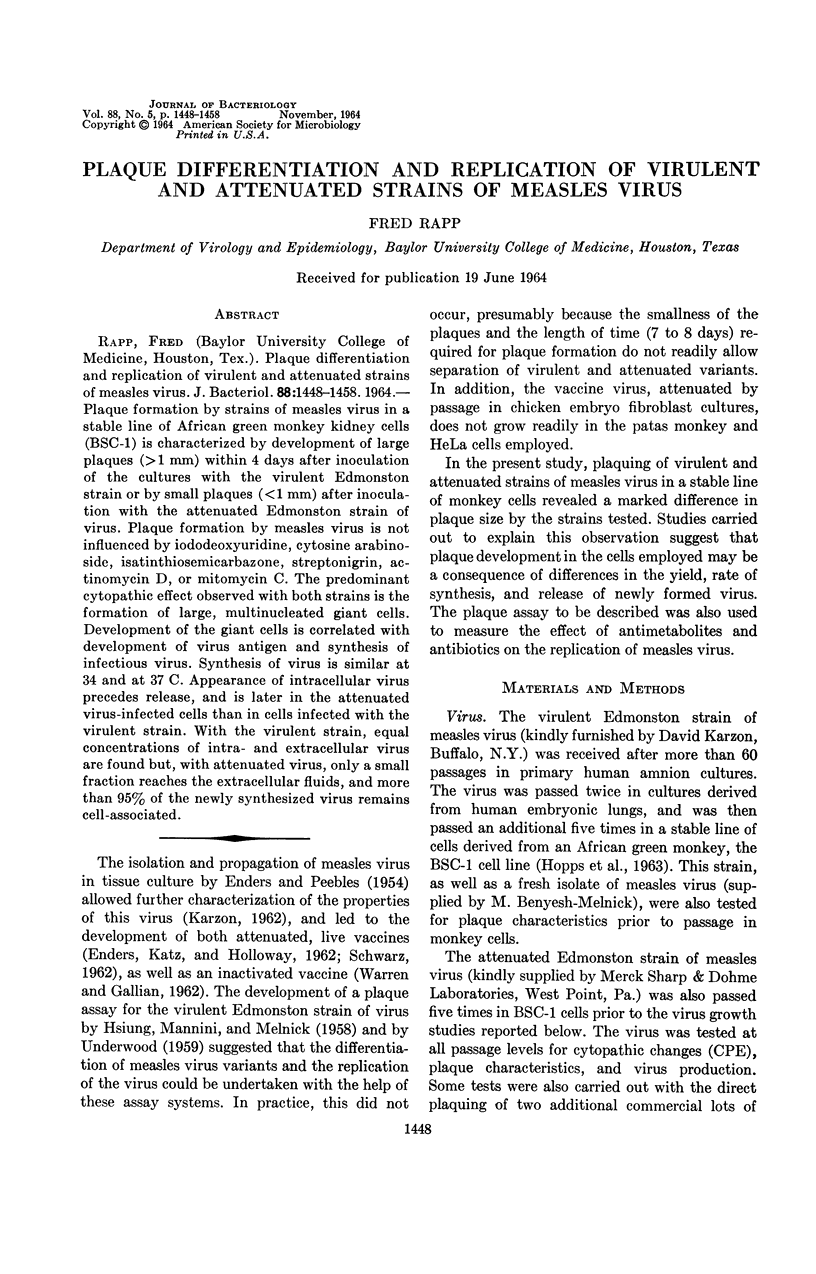
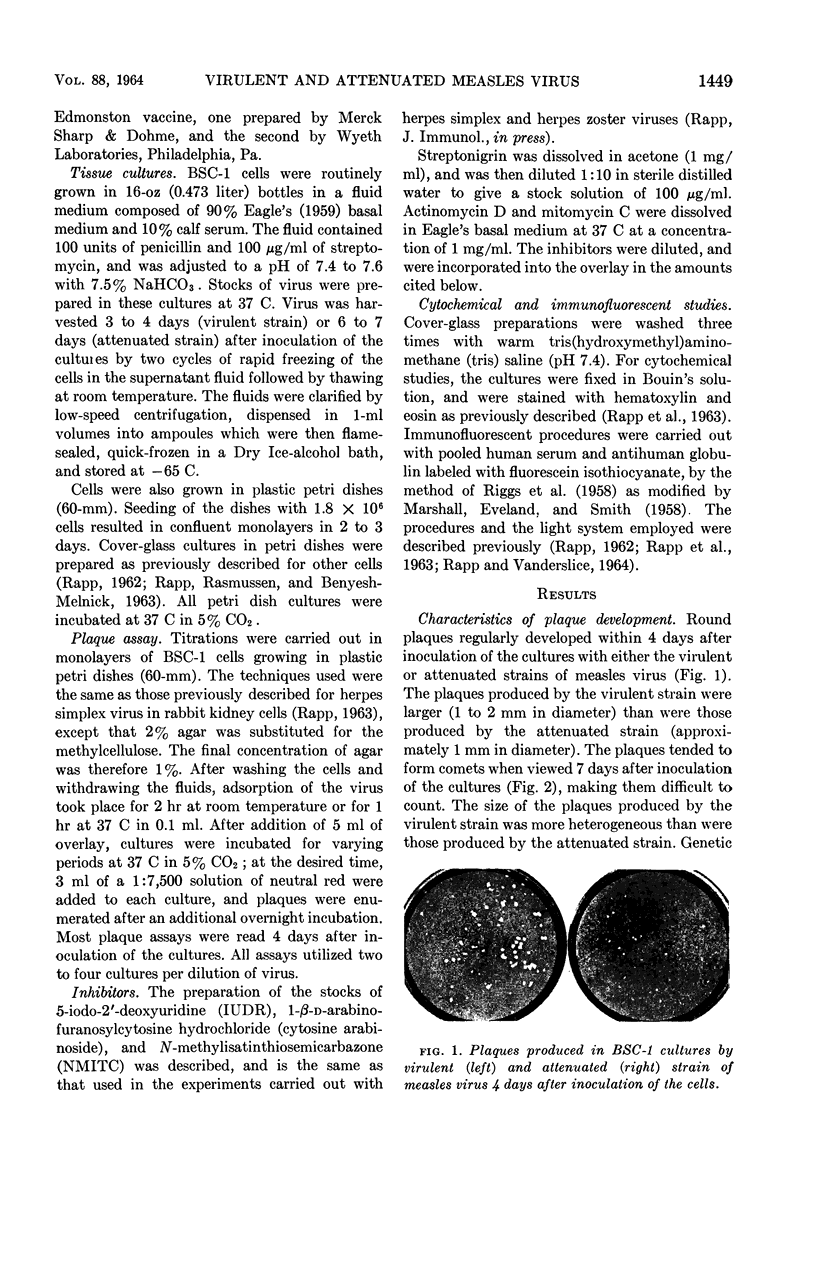
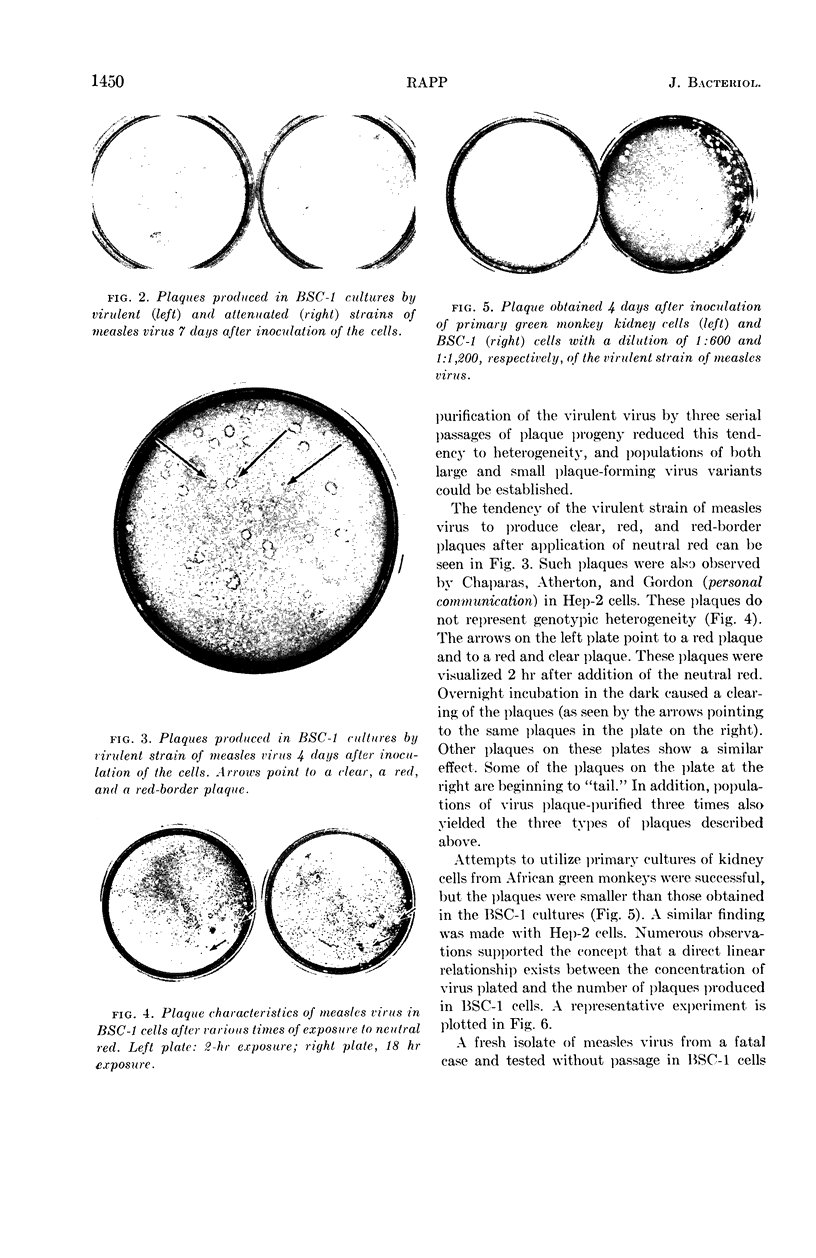
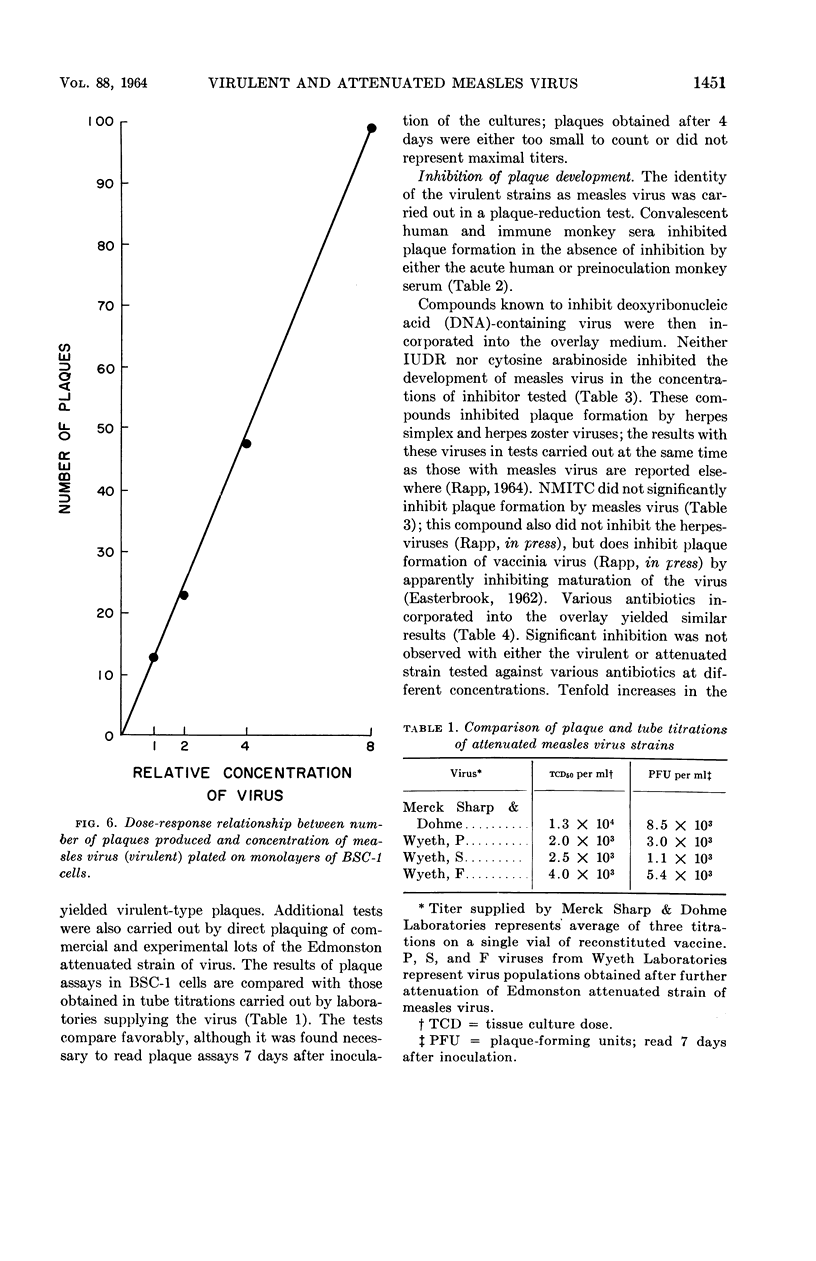
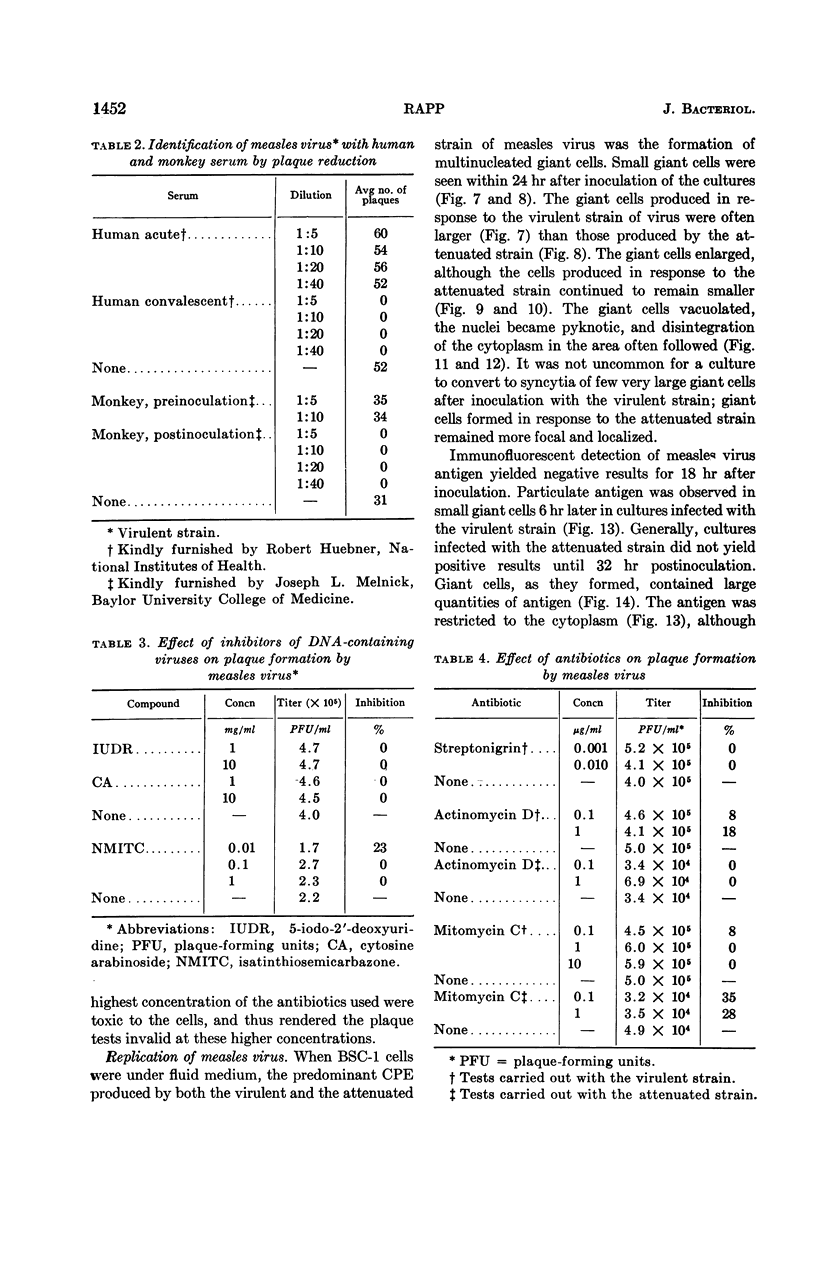
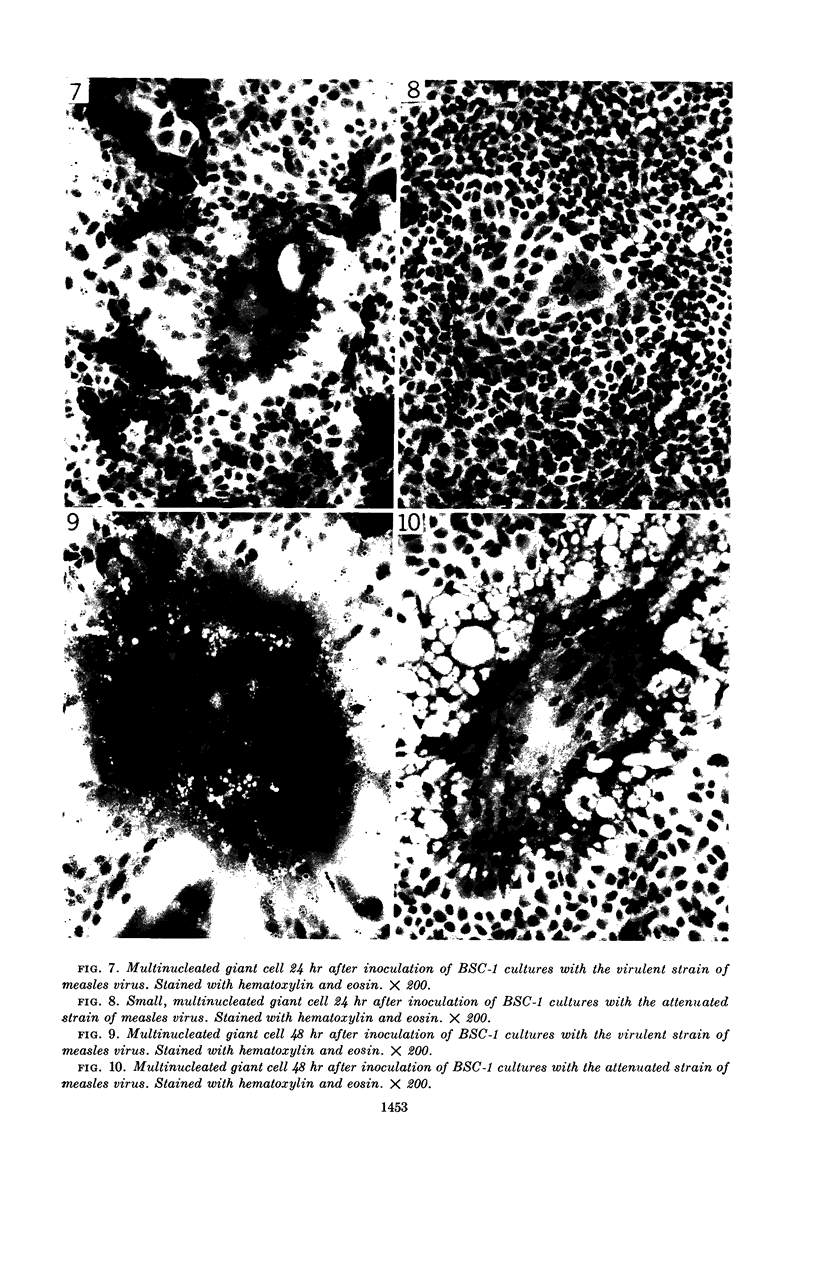
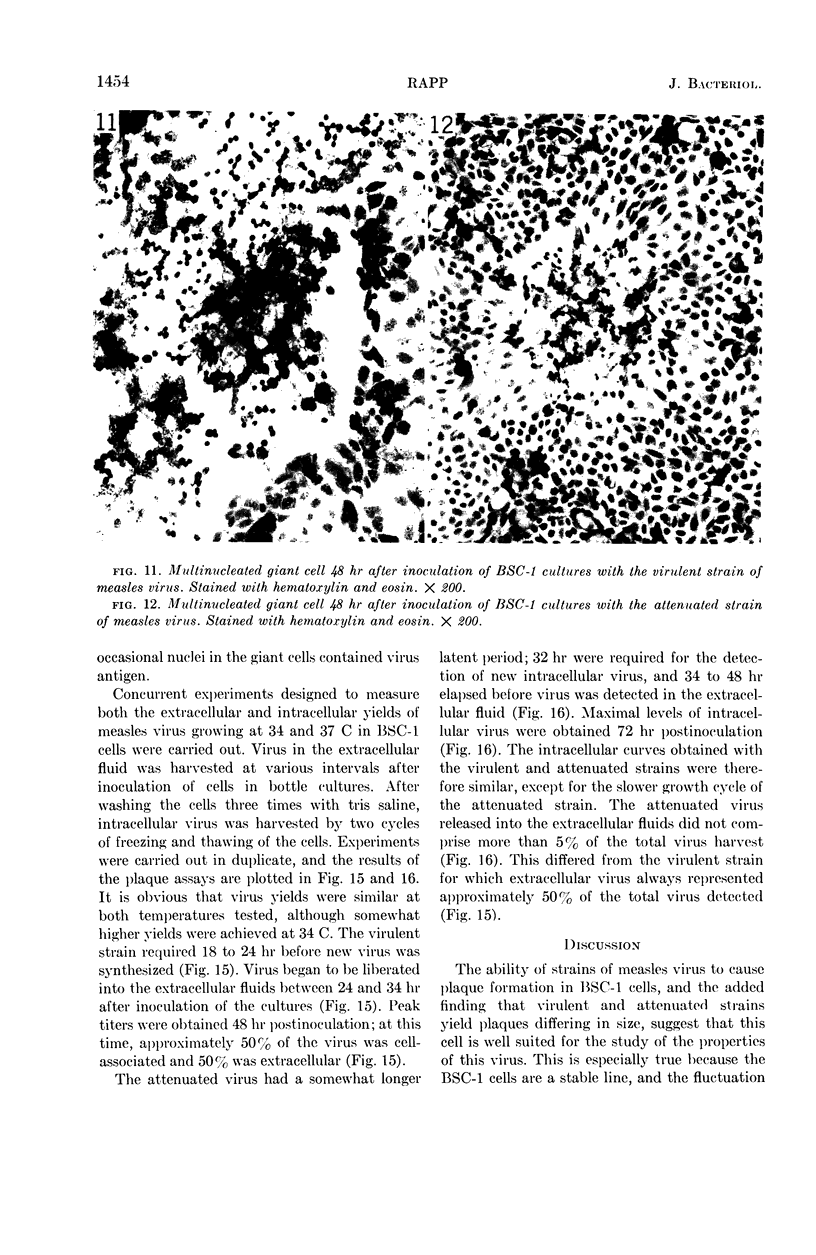

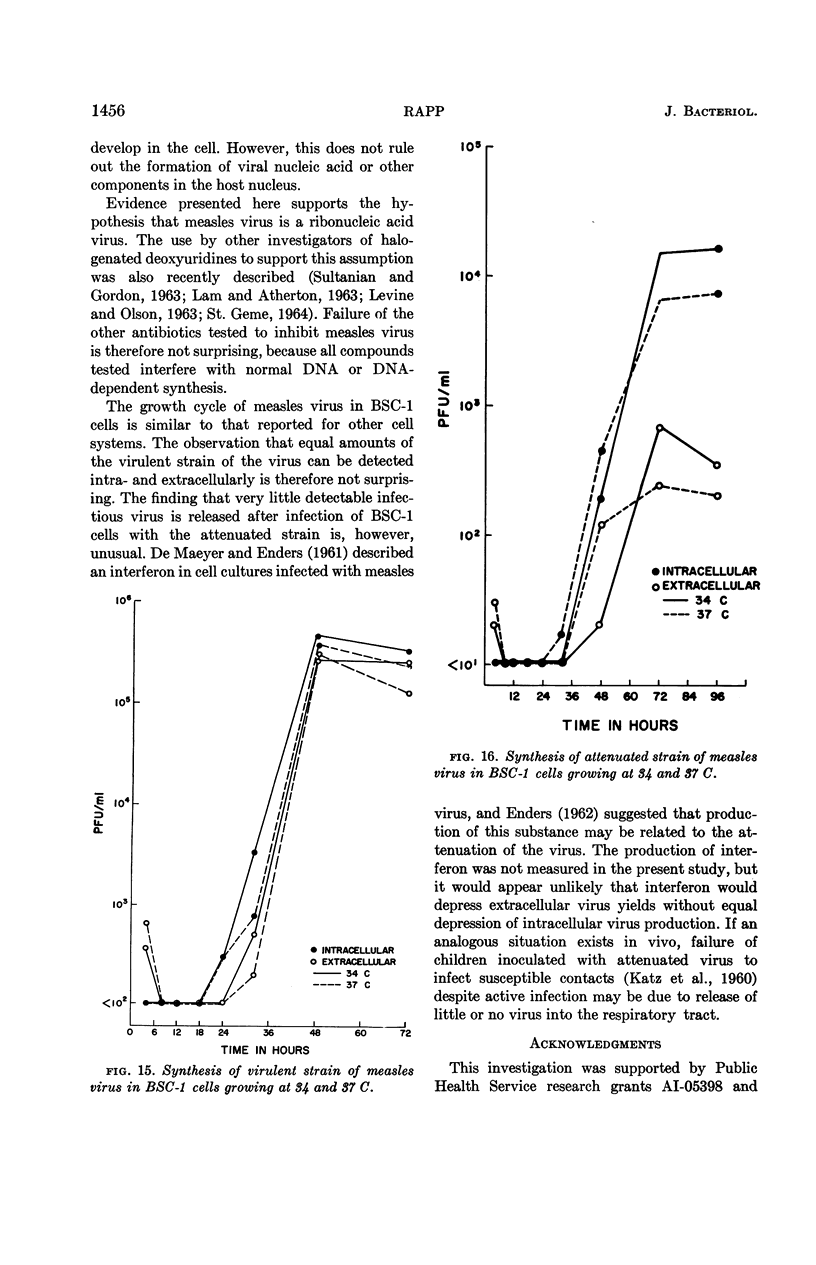
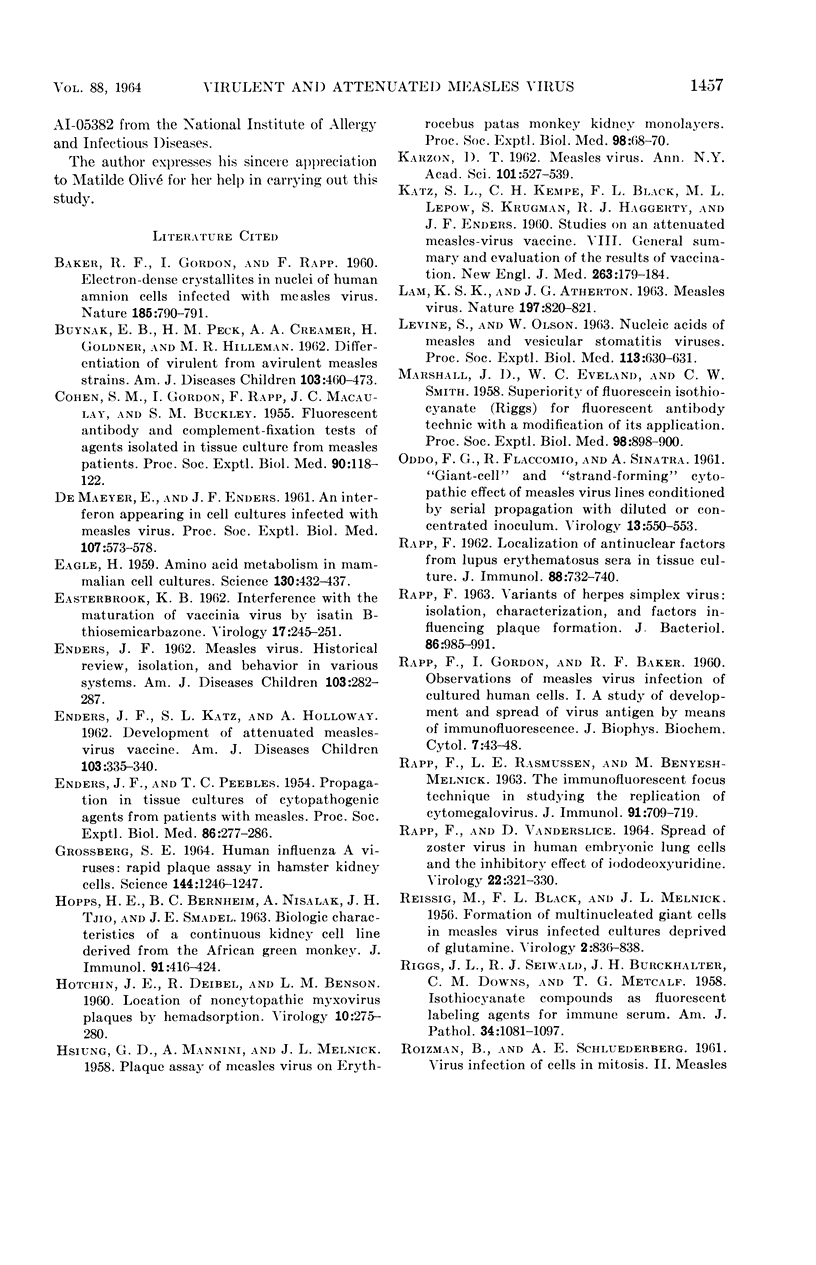
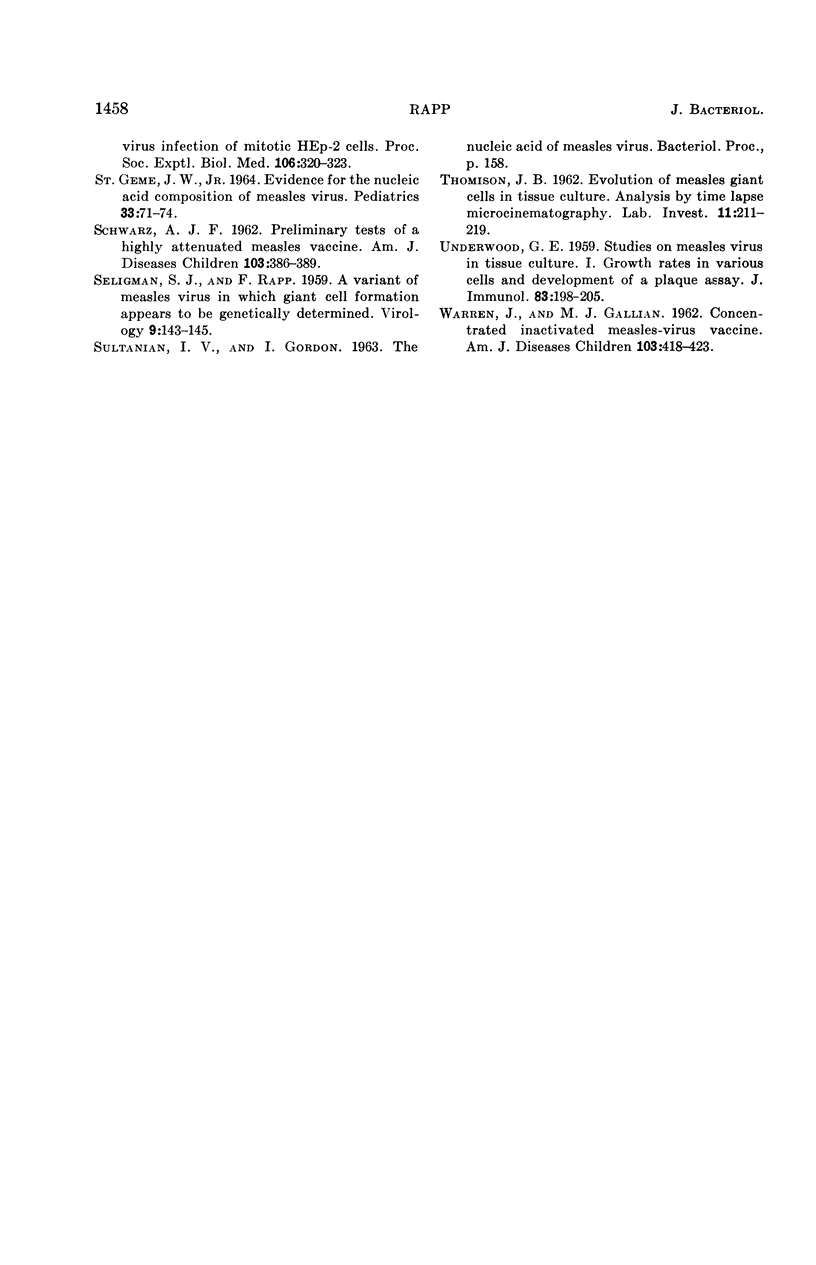
Images in this article
Selected References
These references are in PubMed. This may not be the complete list of references from this article.
- BAKER F. N., SALISBURY G. W. Nuclear size of live and dead bovine spermatozoa. Nature. 1963 Feb 23;197:820–820. doi: 10.1038/197820a0. [DOI] [PubMed] [Google Scholar]
- BAKER R. F., GORDON I., RAPP F. Electron-dense crystallites in nuclei of human amnion cells infected with measles virus. Nature. 1960 Mar 12;185:790–791. doi: 10.1038/185790a0. [DOI] [PubMed] [Google Scholar]
- BLACK F. L., MELNICK J. L., REISSIG M. Formation of multinucleated giant cells in measles virus infected cultures deprived of glutamine. Virology. 1956 Dec;2(6):836–838. doi: 10.1016/0042-6822(56)90063-0. [DOI] [PubMed] [Google Scholar]
- COHEN S. M., GORDON I., RAPP F., MACAULAY J. C., BUCKLEY S. M. Fluorescent antibody and complement-fixation tests of agents isolated in tissue culture from measles patients. Proc Soc Exp Biol Med. 1955 Oct;90(1):118–122. doi: 10.3181/00379727-90-21957. [DOI] [PubMed] [Google Scholar]
- DE MAEYER E., ENDERS J. F. An interferon appearing in cell cultures infected with measles virus. Proc Soc Exp Biol Med. 1961 Jul;107:573–578. doi: 10.3181/00379727-107-26692. [DOI] [PubMed] [Google Scholar]
- EAGLE H. Amino acid metabolism in mammalian cell cultures. Science. 1959 Aug 21;130(3373):432–437. doi: 10.1126/science.130.3373.432. [DOI] [PubMed] [Google Scholar]
- ENDERS J. F., KATZ S. L., HOLLOWAY A. Development of attenuated measles-virus vaccines. A summary of recentinvestigation. Am J Dis Child. 1962 Mar;103:335–340. doi: 10.1001/archpedi.1962.02080020347030. [DOI] [PubMed] [Google Scholar]
- ENDERS J. F. Measles virus. Historical review, isolation, and behavior in various systems. Am J Dis Child. 1962 Mar;103:282–287. [PubMed] [Google Scholar]
- ENDERS J. F., PEEBLES T. C. Propagation in tissue cultures of cytopathogenic agents from patients with measles. Proc Soc Exp Biol Med. 1954 Jun;86(2):277–286. doi: 10.3181/00379727-86-21073. [DOI] [PubMed] [Google Scholar]
- GROSSBERG S. E. HUMAN INFLUENZA A VIRUSES: RAPID PLAQUE ASSAY IN HAMSTER KIDNEY CELLS. Science. 1964 Jun 5;144(3623):1246–1247. doi: 10.1126/science.144.3623.1246. [DOI] [PubMed] [Google Scholar]
- HOTCHIN J. E., DEIBEL R., BENSON L. M. Location of noncytopathic myxovirus plaques by hemadsorption. Virology. 1960 Feb;10:275–280. doi: 10.1016/0042-6822(60)90047-7. [DOI] [PubMed] [Google Scholar]
- HSIUNG G. D., MANNINI A., MELNICK J. L. Plaque assay of measles virus on Erythrocebus patas monkey kidney monolayers. Proc Soc Exp Biol Med. 1958 May;98(1):68–70. doi: 10.3181/00379727-98-23943. [DOI] [PubMed] [Google Scholar]
- LEVINE S., OLSON W. Nucleic acids of measles and vesicular stomatitis viruses. Proc Soc Exp Biol Med. 1963 Jul;113:630–631. doi: 10.3181/00379727-113-28446. [DOI] [PubMed] [Google Scholar]
- MARSHALL J. D., EVELAND W. C., SMITH C. W. Superiority of fluorescein isothiocyanate (Riggs) for fluorescent-antibody technic with a modification of its application. Proc Soc Exp Biol Med. 1958 Aug-Sep;98(4):898–900. doi: 10.3181/00379727-98-24222. [DOI] [PubMed] [Google Scholar]
- ODDO F. G., FLACCOMIO R., SINATRA A. "Giant-cell" and "strand-forming" cytopathic effect of measles virus lines conditioned by serial propagation with diluted or concentrated inoculum. Virology. 1961 Apr;13:550–553. doi: 10.1016/0042-6822(61)90288-4. [DOI] [PubMed] [Google Scholar]
- RAPP F., GORDON I., BAKER R. F. Observations of measles virus infection of cultured human cells. I. A study of development and spread of virus antigen by means of immunofluorescence. J Biophys Biochem Cytol. 1960 Feb;7:43–48. doi: 10.1083/jcb.7.1.43. [DOI] [PMC free article] [PubMed] [Google Scholar]
- RAPP F. Localization of antinuclear factors from lupus erythematosus sera in tissue culture. J Immunol. 1962 Jun;88:732–740. [PubMed] [Google Scholar]
- RAPP F., RASMUSSEN L. E., BENYESH-MELNICK M. THE IMMUNOFLUORESCENT FOCUS TECHNIQUE IN STUDYING THE REPLICATION OF CYTOMEGALOVIRUS. J Immunol. 1963 Nov;91:709–719. [PubMed] [Google Scholar]
- RAPP F., VANDERSLICE D. SPREAD OF ZOSTER VIRUS IN HUMAN EMBRYONIC LUNG CELLS AND THE INHIBITORY EFFECT OF LODODEOXYURIDINE. Virology. 1964 Mar;22:321–330. doi: 10.1016/0042-6822(64)90023-6. [DOI] [PubMed] [Google Scholar]
- RAPP F. VARIANTS OF HERPES SIMPLEX VIRUS: ISOLATION, CHARACTERIZATION, AND FACTORS INFLUENCING PLAQUE FORMATION. J Bacteriol. 1963 Nov;86:985–991. doi: 10.1128/jb.86.5.985-991.1963. [DOI] [PMC free article] [PubMed] [Google Scholar]
- RIGGS J. L., SEIWALD R. J., BURCKHALTER J. H., DOWNS C. M., METCALF T. G. Isothiocyanate compounds as fluorescent labeling agents for immune serum. Am J Pathol. 1958 Nov-Dec;34(6):1081–1097. [PMC free article] [PubMed] [Google Scholar]
- SCHWARZ A. J. Preliminary tests of a highly attenuated measles vaccine. Am J Dis Child. 1962 Mar;103:386–389. doi: 10.1001/archpedi.1962.02080020398042. [DOI] [PubMed] [Google Scholar]
- SELIGMAN S. J., RAPP F. A variant of measles virus in which giant cell formation appears to be genetically determined. Virology. 1959 Sep;9:143–145. doi: 10.1016/0042-6822(59)90109-6. [DOI] [PubMed] [Google Scholar]
- ST GEME J. W., Jr EVIDENCE FOR THE NUCLEIC ACID COMPOSITION OF MEASLES VIRUS. Pediatrics. 1964 Jan;33:71–74. [PubMed] [Google Scholar]
- THOMISON J. B. Evolution of measles giant cells in tissue culture. Analysis by time lapse microcinematography. Lab Invest. 1962 Mar;11:211–219. [PubMed] [Google Scholar]
- UNDERWOOD G. E. Studies on measles virus in tissue culture. I. Growth rates in various cells and development of a plaque assay. J Immunol. 1959 Aug;83:198–205. [PubMed] [Google Scholar]
- WARREN J., GALLIAN M. J. Concentrated inactivated measlesvirus vaccine. Preparation and antigenic potency. Am J Dis Child. 1962 Mar;103:418–423. [PubMed] [Google Scholar]





